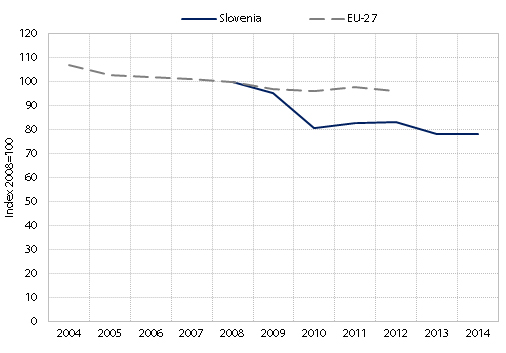ENVIRONMENTAL WELL-BEING - Land and ecosystems
The indicator Farmland birds index measures, based on fieldwork censuses, detected changes in the populations (number of pairs) of characteristic farmland birds. Due to their mobility and sensitivity, birds are an important indicator of biodiversity and changes in the environment. Greater biodiversity provides greater stability of ecosystems and their ability to perform ecosystem services. Growth of the indicator has a positive impact on well-being.
Figure: Farmland birds index, Slovenia and the EU, 2008−2014 (index, 2008=100)

Source of data: DOPPS-BirdLife Slovenia, Slovenian Environment Agency: Environmental indicators in Slovenia - NB14 Farmland birds, Eurostat.
In 2013, the population of farmland birds in Slovenia slightly declined compared to 2012 and in 2014 remained at the same level. Compared to 2008, it was 22% lower. Characteristic farmland birds depend on extensive methods of farming, so their populations mostly decline due to intensification of farming (decreasing the mosaic of arable land, meliorations, decrease in the area of grassland, increased pesticide input, etc.), and sometimes the pressure in the opposite direction, when due to withdrawal of farming arable land is turning into forest. The trend of declining of the population of farmland birds was also detected in the EU overall.
Results of supplementary indicators show:
Estimates of the conservation status of species of European interest show bad or inadequate status of at least half (51%) of the species in Slovenia in the 2007–2012 period. According to the previous estimates (for the 2004–2006 period) the share was 61%. A comparison with the EU shows a slightly better situation in Slovenia and a greater progress in the conservation of species.
In 2013, Natura 2000 areas slightly increased, which shows the increase in the already high importance of Slovenia in preserving or achieving a favourable status of species and habitat types of EU conservation concern. Natura 2000 areas represent 25% (conservation of important bird species) or 33% (conservation of important habitats) of the territory of Slovenia, which is almost twice the EU average (13% and 14%, respectively).
Built-up areas, which are to a large extent irreversibly altered so that the implementation of essential environmental functions of soil is reduced or disabled, covered a smaller share of Slovenia in 2012 (2.8%) than the EU average (2006: 4.3%), but with urbanisation and new construction the area is increasing.
The share of utilised agricultural area increased in 2014 to 23.8% and was much lower than the EU average (2007: 42%). With some annual variations, utilised agricultural area in Slovenia has been slowly declining since 2000. In this period the share of arable land and kitchen gardens in total utilised agricultural area has been growing.
